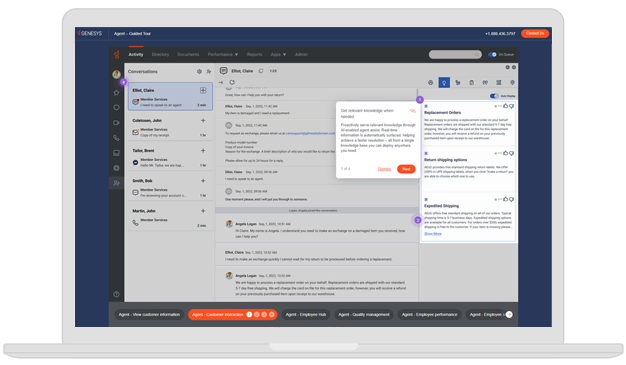
Workforce management (WFM) has evolved from a back-office function into a strategic driver of business performance. From controlling labor costs to improving employee engagement, WFM systems offer measurable value across customer service operations. But in an era of tighter budgets and increased accountability, HR and operations leaders must be able to quantify that value.
Understanding the return on investment (ROI) of workforce management is essential — not just to justify the budget, but to optimize it. In this article, we’ll explore how to evaluate WFM ROI, what benefits to track and why a data-driven approach to workforce planning is key to long-term success.
Why does workforce management matter?
We all understand the importance of planning for unexpected events, such as severe weather or heavy traffic on the way to the airport. The same logic applies to business. Companies must anticipate future scenarios with their customers and employees — from daily fluctuations to major disruptions.
WFM enables that readiness. It helps organizations predict and prepare for changes in customer demand through voice, chat or other digital channels. By aligning staffing with shifting needs, WFM ensures that businesses stay responsive and efficient. And when implemented effectively, it also delivers measurable ROI.
Key components of modern workforce management
A core function of modern WFM is determining how many agents your business needs – and when. That starts with understanding the volume of customer interactions across channels so you can accurately forecast demand and schedule staff coverage.
Forecasting and scheduling features ensure the right people are available at the right days and times, but WFM goes further. Today’s solutions support long-range planning, helping you look months — or even a year — ahead. This is the role of capacity planning: Identifying future needs early enough to recruit, train and onboard staff before demand increases.
While planning far ahead is essential for efficiency, you also need to see and understand what’s happening now. This “intraday” monitoring shows you if service levels are aligned with your plan.
Let’s say you were planning for a campaign launch months in advance that would give special discounts to early purchasers. But the day before the launch, there’s a strike that hits ground transportation and your product is not in stores. Customers are calling. How do you anticipate potential problems and resolve them?
Intra-day capabilities tell you whether your average handle times can still be addressed, and if you are still in compliance as you adjust employee schedules. For example, are the agents starting their work and ending their work time in a way that’s compliant? Are they still taking their breaks at a specific time?
You’ll need to make adjustments, especially for something that was not planned, and they need to be validated as compliant in real time.
Understanding ROI in workforce management
Measuring the ROI of WFM is essential to understanding its full business impact. From staffing efficiency to employee retention, WFM delivers measurable value that goes beyond day-to-day operations. Let’s examine the positive impact this can have on your business.
WFM helps organizations optimize staffing, control total costs and improve employee retention. Core WFM functions like forecasting, scheduling, intraday monitoring and capacity planning work together to balance workload with workforce availability with the automation needed to run a cost-effective business.
For example, overstaffing results in paying employees for work when they’re not needed. Understaffing, on the other hand, often leads to long customer wait times and lost business.
If a customer waits 30 minutes to speak to an agent, there’s a high risk they won’t return. WFM tools help avoid these scenarios by alerting teams to coverage issues in real time.
The ROI also extends to employee retention. When agents are offered flexible and predictable schedules, job satisfaction improves. This reduces turnover is a major cost for businesses.
According to the Society for Human Resource Management, the cost of replacing an employee can range from 50% to 200% of their annual salary, depending on their level. And onboarding a new agent – from hiring to full proficiency — is far more expensive than retaining a skilled one.
High turnover could also create reputational risk. Former employees might share negative experiences, amplifying dissatisfaction and making it harder to attract new talent. WFM helps address these challenges by helping to create a more stable, efficient and employee-friendly workplace.
Common metrics used to measure WFM ROI
Improvement in average handle time and in absenteeism, and reduction in turnover or attrition rates, are all metrics that help measure ROI. And they’re typically part of a WFM strategy. Average handle time is found on dashboards, as well as the number of abandoned calls and the service levels you’re following.
But management typically wants to see ROI that’s about reduced costs, such as lowering overtime hours. There are metrics that you track through the day, but others let you know if you’re losing money or increasing revenue, including forecast accuracy for staffing or scheduling, or occupancy.
This varies significantly from program to program depending on several factors, such as staffing rules, opening hours or volume of transactions. And that time saved can translate directly into costs for the company.
Beginner’s guide: How to calculate WFM ROI step by step
Measuring ROI from your WFM system helps demonstrate its impact on efficiency, employee satisfaction and business outcomes. These steps are a good starting point on the basics — what data to gather, how to calculate return and how to use insights to improve over time. Whether you’re justifying an investment or optimizing an existing platform, a clear picture of ROI enables smarter decision-making.
What you’ll need to get started when calculating WFM ROI
Gather baseline metrics and WFM system data. This includes implementation and licensing costs, training and integration expenses and any ongoing support fees.
You’ll also need operational data: employee attrition rates, average handle time, overtime hours, schedule adherence and absenteeism. Historical benchmarks will help you see the difference before and after WFM adoption.
Finally, collaborate with other teams, like finance or operations, to align on measurement criteria. This supports buy-in and accuracy from the start.
Step 1: Identify all relevant costs and investments
Start by outlining all direct and indirect costs of your WFM solution. These include software licenses, implementation services, integration with other systems, user training, ongoing support and internal resources required for adoption.
Enhance your cost model with a scenario modeling approach. This lets you assess alternative options, such as outsourcing, adding headcount or extending hours and compare them to WFM-enabled performance. It adds rigor — and defensibility — to the investment conversation.
Don’t forget to account for hidden costs, like temporary productivity dips during onboarding or costs tied to system configuration and compliance. Document both one-time and recurring expenses. This gives you a full picture of what’s been invested so far and sets the foundation for comparing these costs against actual performance gains.
Step 2: Determine the quantifiable benefits of WFM
Next, identify measurable outcomes your WFM system delivers. These might include reduced overtime spend, improved forecast accuracy, lower attrition, better schedule adherence and higher employee satisfaction.
For example, if you used to lose $50,000 annually in overstaffing and now that’s cut in half, that $25,000 savings is part of your ROI. Other benefits include shorter AHT, higher service levels and fewer missed shifts.
Use pre- and post-implementation data to validate gains. Where possible, tie improvements to dollar values to show the real business impact.
Step 3: Analyze results and plan for continuous improvement
Once you have your ROI figure, dig deeper. Which areas delivered the most value? Where has backlog risk decreased? Where could improvements be stronger?
Look at trends across departments, teams or time periods. Consider running quarterly ROI reviews to track gains over time and align with evolving business needs.
Use findings to inform future investments, such as expanding WFM tools to new regions or adding AI-driven features. Remember, ROI isn’t a one-time number. It’s an ongoing tool for improving operations, aligning priorities and proving the business value of your WFM strategy.
Conclusion
Workforce management keeps the outcomes you want in check, and close to the objectives that your business wants. This includes your percentage of service levels and percentage of customers whose needs are being addressed.
By ensuring that agents are available at the right time with the right skills, you can deliver on the brand promise made to your customers.
Frequently asked questions
How long does it take to see ROI from a WFM system?
It depends on your environment, such as how many systems you need to integrate and the complexity of your operations. You’ll also measure your ROI at different intervals and for different purposes.
Some benefits, like improved schedule adherence or reduced overtime, might appear within weeks. Others, such as lower turnover or increased customer satisfaction, take longer to surface.
If you’re transitioning from spreadsheets, you’ll start seeing value as soon as you’re able to deliver real-time information to agents and managers. As adoption expands, the impact grows, resulting in measurable improvements across staffing, performance and overall workforce efficiency.
What are the most overlooked costs in WFM implementation?
One of the most overlooked costs is the time and effort required for system configuration and migration. Businesses often assume data will transfer cleanly from one platform to another.
But while historical metrics like handle time may migrate, agent-specific details – like skills, queues and schedules – often don’t. This means teams must rebuild key elements in the new system, which is time-consuming and complex. This includes the migration of any customizations you’ve built.
Many organizations underestimate this effort or attempt it alone, leading to costly errors. That’s why it’s essential to work with a vendor that offers expert guidance throughout the migration process.
Can workforce management (WFM) software improve employee satisfaction?
Yes, WFM software can significantly improve employee satisfaction by providing more flexible, predictable schedules and reducing last-minute changes. It empowers employees to swap shifts, request time off and manage preferences — all within a system that still meets business needs. When employees feel heard and supported, engagement and retention improve. This can increase productivity and lower turnover as well as associated costs.
How do I ensure my ROI calculation is accurate?
To ensure accuracy when calculating ROI with cloud-based WFM tools, start by capturing a baseline of key metrics before implementation, such as turnover, overtime, schedule adherence and service levels. Track improvements using real-time data dashboards and reports built into your WFM system.
In your calculations, include both direct cost savings, such as reduced overtime, and indirect gains such as improved retention or customer satisfaction. Cloud-based tools make it easier to continuously access, measure and validate these outcomes.
How does WFM help ensure that employee business practices are compliant with global regulations?
WFM solutions are designed to help businesses stay compliant with labor laws, union rules and regional or industry-specific agreements. Modern, cloud-based WFM systems allow you to build compliance requirements, such as mandated rest days, maximum weekly hours, or local scheduling laws, directly into your forecasting, scheduling and planning. By doing so, WFM ensures that employee schedules automatically align with legal and contractual obligations.
To support compliance adherence, choose a WFM vendor that offers expert services to configure the system based on your unique operational needs and regulatory environment.
How will WFM support future resource management?
WFM is evolving beyond managing people to managing all related resources, including AI, bots and virtual agents. As automation takes on more tasks, WFM will help coordinate when a human needs to step in, and when AI can handle the work.
In hybrid work environments and gig-based models, WFM will also connect front office agents with back-office teams, ensuring seamless collaboration and scheduling. Whether it’s planning, coaching sessions or adapting during system outages, WFM will remain critical to managing both human and digital resources effectively.






